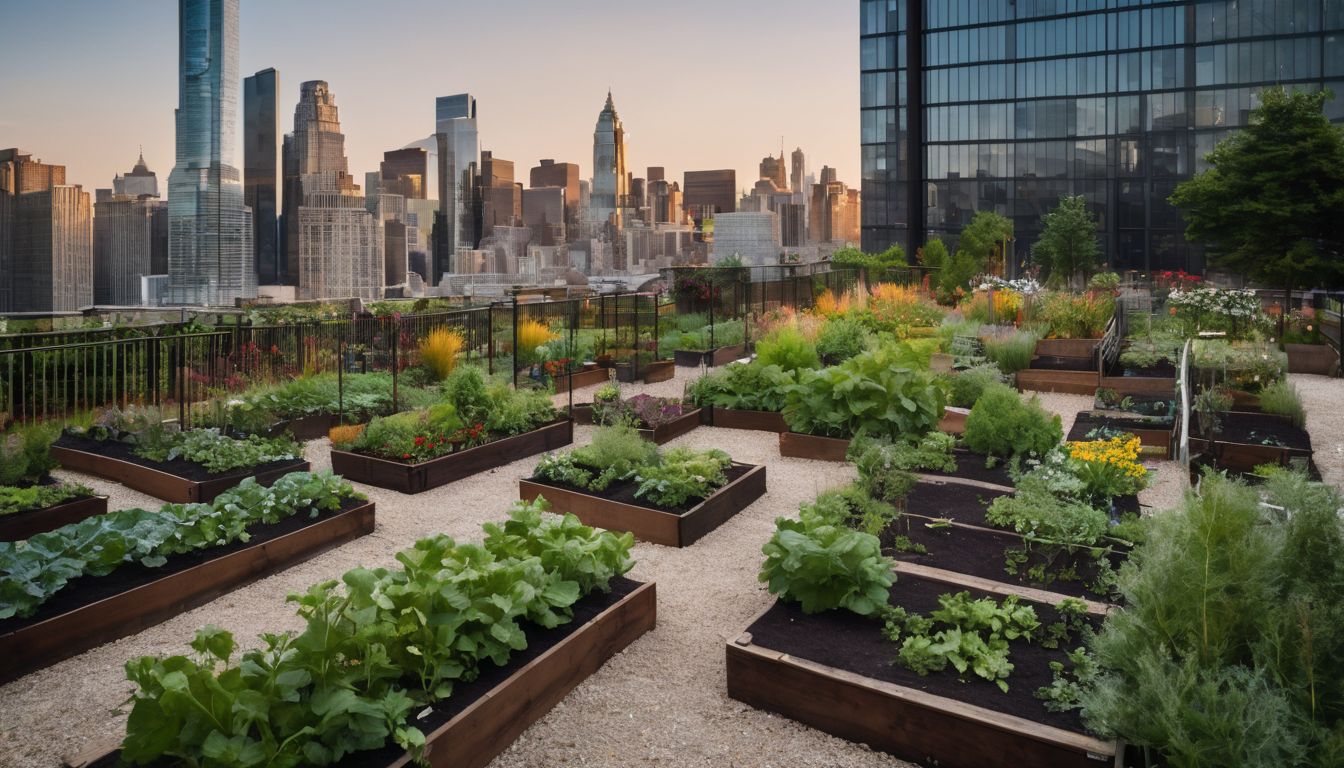Communities worldwide are grappling with how to grow while protecting our planet. A striking fact: eco-friendly development can cut greenhouse emissions by up to 59%. This article guides you through crafting a sustainable community blueprint, step by careful step.
Read on for a green future.
Key Takeaways
- Community involvement is essential for the success of eco – friendly development, ensuring projects meet local needs while fostering pride and ownership.
- Using technology in sustainable projects leads to efficient energy and waste management, contributing significantly to environmental protection.
- Establishing key partnerships with local businesses supports economic growth and reduces carbon footprints, promoting a resilient local economy.
- Regular evaluation and communication are vital for tracking progress towards sustainability goals and maintaining transparency within the community.
- Adopting sustainable practices across economic, social, environmental aspects ensures long-term benefits for residents’ well-being and planetary health.
The Importance of Sustainable Community Development
Sustainable community development is crucial for building better futures and ensuring the well-being of both current and future generations. This requires a comprehensive sustainability plan that addresses economic, social, environmental, and legislative resilience aspects.
Making a project sustainable
Making a project sustainable involves integrating ecofriendly practices at every stage, from planning to execution. Use local knowledge and green building practices to ensure that developments benefit the community without harming the environment.
Focus on renewable energy sources and low-impact development techniques to keep the carbon footprint small.
Incorporate environmental justice into your approach by ensuring equitable development for all community members. Engage volunteers in activities that promote sustainability and strengthen social sustainability.
Regular evaluation of environmental impact helps maintain a project’s sustainability, adapting strategies as needed for continued success in conservation efforts.
Building better futures
By embracing sustainable practices, we can ensure a brighter future for generations to come. Sustainable community development paves the way for environmentally conscious living, economic prosperity, and social cohesion.
It also provides opportunities for individuals to contribute towards climate change mitigation and environmental stewardship while fostering a sense of responsibility towards our planet.
Embracing sustainable urban planning and green initiatives facilitates the transition towards a more resilient and eco-friendly future, where communities thrive in harmony with nature.
Involving the community is key to building better futures through sustainable projects. Engaging local residents in land use strategies, volunteering for sustainability efforts, and supporting local businesses all play crucial roles in creating climate-resilient communities that reduce carbon footprints while fostering economic growth.
The need for a sustainability plan
Sustainable community development requires a comprehensive sustainability plan. This plan should encompass economic, social, and environmental aspects to ensure long-term success. By establishing clear goals and strategies for managing resources and minimising environmental impact, we can create thriving communities that are resilient to future challenges.
A sustainable plan is crucial in achieving lasting positive change. Engaging with stakeholders, investing in green infrastructure, and reducing carbon footprint are all integral components of a successful sustainability strategy.
With these measures in place, communities can work towards creating a better future for generations to come by embracing eco-friendly initiatives.
Key Elements of Sustainable Community Development
Economic sustainability, social sustainability, environmental sustainability, and legislative resilience are the key elements of sustainable community development. Each element plays a crucial role in creating a well-rounded and enduring project.
Economic sustainability
Local economic sustainability is a vital component of any community development project. It involves building a resilient economy that provides job opportunities and supports local businesses.
By prioritising economic sustainability, we can create a thriving community where residents have access to meaningful employment and support for their entrepreneurial ventures.
By focusing on supporting local businesses, creating job opportunities, and fostering economic growth within the community, sustainable development projects can contribute to the overall well-being of residents.
Embracing economic sustainability not only ensures financial stability but also enhances the quality of life for all members of the community.
Social sustainability
Social sustainability is a vital aspect of community development, focusing on fostering inclusive and equitable societies for all members. This involves promoting social cohesion, equality, and diversity within the community to ensure everyone has access to opportunities and resources.
By encouraging participation in decision-making processes and valuing diverse perspectives, communities can work towards creating a more socially sustainable environment.
Furthermore, initiatives that support education, healthcare, affordable housing, and cultural expression contribute to social sustainability by addressing the basic needs of individuals within the community.
Implementing strategies that promote volunteerism and civic engagement also play a significant role in building strong social connections and enhancing overall well-being for residents.
Environmental sustainability
Environmental sustainability is a crucial component of any community development project. It involves making conscious choices to minimise the impact on the natural environment and preserve resources for future generations.
Implementing eco-friendly initiatives, reducing carbon footprints, and promoting conservation are all essential aspects of environmental sustainability in community planning.
When considering sustainable urban development or place-based initiatives, it’s vital to prioritise environmental conservation. This can involve creating green spaces, implementing energy-efficient technologies, and supporting projects that reduce waste and pollution.
Legislative resilience
Moving from the focus on environmental sustainability to legislative resilience is crucial in ensuring that eco-friendly community development projects are protected and supported by laws and regulations.
Legislative resilience involves creating policies and regulations that encourage sustainable practices, support conservation efforts, and reduce carbon footprints within a community.
These legislative measures play a vital role in upholding the long-term sustainability of community projects by providing legal frameworks for environmentally conscious initiatives.
Legislative resilience also serves as a safeguard against potential threats to sustainable development, ensuring that eco-friendly practices are upheld through enforceable laws. By advocating for legislation that supports place-based development and eco-friendly initiatives, communities can pave the way for long-lasting positive impact on their environment.
Strategies for Developing Sustainable Community Projects
Establishing key partnerships with local organisations and businesses can help create a network of support for eco-friendly initiatives. Involving the community in the planning and decision-making process ensures that their needs and concerns are addressed, leading to greater buy-in and success for sustainable projects.
Establishing key partnerships
Key partnerships are crucial for sustainable community development. By collaborating with local businesses, government agencies, and non-profit organisations, eco-friendly initiatives can reach more people and have a greater impact.
Engaging in open communication with these partners ensures that all stakeholders contribute to the success of the project while reducing carbon footprints and supporting conservation efforts.
Community engagement is at the heart of sustainable community planning. By establishing key partnerships within the community, place-based development becomes a joint effort to reduce environmental impacts while building better futures for everyone involved.
Involving the community
Engaging the community is vital for the success of sustainable development projects. Encouraging local participation fosters a sense of ownership and commitment, ensuring that initiatives are aligned with community needs and values.
By involving residents in decision-making processes, eco-friendly projects can better address specific concerns, promote buy-in, and build lasting support for environmentally friendly initiatives within the community.
Furthermore, collaboration with local stakeholders empowers individuals to take an active role in implementing and sustaining ecofriendly initiatives. This involvement leads to increased awareness, shared responsibility towards reducing carbon footprints, and long-term commitment to building a greener future for everyone involved.
Regular evaluation and communication
Regular evaluation and communication play a crucial role in sustainable community development. It is essential to regularly assess the progress of eco-friendly projects, ensuring that they align with the set environmental goals and standards.
Regular communication with stakeholders, including local residents and businesses, fosters transparency and trust within the community.
By conducting frequent evaluations and maintaining open lines of communication, eco-conscious individuals can ensure that their community projects are on track towards reducing carbon footprints and promoting environmental conservation efforts.
These practices allow for adjustments to be made as needed, leading to more successful outcomes in creating sustainable communities for future generations.
Demonstrating previous success in sustainability
Demonstrating previous success in sustainability is crucial for gaining community trust and support for future eco-friendly projects. Showcase the positive impact of past sustainable initiatives, focusing on carbon footprint reduction, community engagement, and the support of local businesses.
Highlighting successful outcomes can inspire confidence in the effectiveness of sustainable development efforts and encourage greater participation from all stakeholders.
By sharing tangible results and success stories, communities can see the value of embracing environmental conservation practices. Demonstrating how eco-friendly initiatives have positively impacted economic growth, social well-being, and environmental preservation will encourage wider adoption of sustainable strategies.
Engaging with real-life examples will drive home the importance of continued dedication to creating a greener future for all.
Moving forward, technology plays a pivotal role in advancing sustainable community projects by providing innovative solutions that benefit both people and planet. Embracing technological advancements will enable communities to take significant strides towards a more environmentally conscious future.
Supporting local businesses
Incorporating local businesses into sustainable community development projects is crucial for fostering economic sustainability and supporting the growth of the local economy. By sourcing materials and services from nearby businesses, projects can reduce their carbon footprint and contribute to building a resilient local economy.
This approach not only strengthens community relationships but also promotes job creation and retention, contributing to the overall well-being of the area.
By ensuring that project contracts and procurement processes prioritise local enterprises, it’s possible to support small businesses while aligning with sustainable development goals.
The Role of Technology
Utilising technology for sustainable development is crucial in today’s world. Technology can help in monitoring and managing energy usage, waste disposal, and water consumption, leading to more efficient and eco-friendly community development projects.
Utilizing technology for sustainable development
Technology plays a crucial role in driving sustainable development, offering innovative solutions to address environmental challenges. Implementing smart grids and energy-efficient systems can help reduce carbon footprints and minimise the ecological impact of community projects.
Furthermore, leveraging digital platforms for efficient waste management and water conservation initiatives can significantly contribute to environmental sustainability. Embracing eco-friendly technologies not only ensures the long-term viability of community developments but also sets a positive example for future projects.
Moving forward, let’s explore the examples of technology in action within sustainable community projects.
Examples of technology in action
Technology plays a crucial role in sustainable community projects. By implementing smart grids and energy-efficient solutions, communities can significantly reduce their carbon footprint, leading to environmentally friendly development.
Utilising advanced waste management systems encourages recycling and minimises landfill waste, contributing to the overall environmental sustainability of the community.
In addition to this, incorporating digital platforms for community engagement enables efficient communication among residents and stakeholders. This promotes social connectivity while reducing the need for physical travel, thus cutting down on carbon emissions.
The Future of Sustainable Community Development
The future of sustainable community development is dependent on the active involvement of the community and embracing sustainable practices for a better future. It requires a collaborative effort to create environmentally friendly communities for generations to come.
The importance of community involvement
Community involvement is crucial for the success of sustainable community development projects. When local residents actively participate in planning and decision-making, projects are more likely to address the specific needs of the community while fostering a sense of ownership and pride.
By involving the community, it becomes easier to create solutions that are relevant and sustainable in the long term.
Engaging with local stakeholders also helps build trust and strengthen relationships, leading to more effective implementation of sustainable initiatives. Additionally, community involvement can inspire innovative ideas and approaches that may not be apparent to external parties.
Embracing sustainable practices for a better future
Embracing sustainable practices is essential for shaping a better future for our communities. By prioritising eco-friendly initiatives, we can create long-term benefits for the environment and the well-being of residents.
Taking conscious steps towards sustainable development, such as reducing carbon footprints, promoting green spaces, and supporting renewable energy sources will contribute to a healthier and more resilient community.
Adopting sustainable practices isn’t just about the present; it’s an investment in tomorrow. By embracing eco-friendly solutions today, we can ensure a brighter and more environmentally secure future for generations to come.
Conclusion
In conclusion, sustainable community development is vital for creating a better future. Engaging the community and utilising technology are crucial elements in planning eco-friendly projects.
Supporting local businesses and demonstrating previous success in sustainability also play key roles in achieving effective and lasting results.
FAQs
1. What are eco-friendly community development projects?
Eco-friendly community development projects focus on building or improving communities with respect for the environment and sustainable practices at their core.
2. Why is place-based development important in eco-friendly projects?
Place-based development is key because it considers the unique characteristics of a location, ensuring that eco-friendly initiatives cater specifically to local needs whilst preserving the natural surroundings.
3. How can we ensure our community project is eco-friendly?
Ensure your project incorporates renewable energy sources, uses sustainable materials, and minimises environmental impact through careful planning and design.
4. Can local residents get involved in planning these types of projects?
Yes! Local residents often play an essential role in planning eco-friendly community development projects by sharing their insights and helping to shape a project that benefits everyone.





